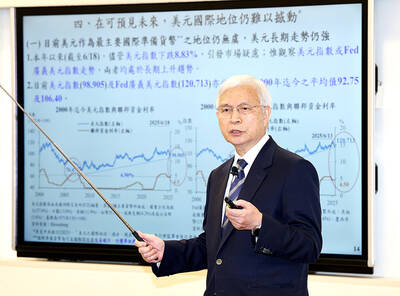Win Semiconductors Corp (穩懋半導體), the world’s largest pure-play gallium arsenide foundry, yesterday said it expects a low-teens percentage decline in revenue this quarter as demand from smartphones weakens during the slack season and unfavorable foreign-exchange rates continue to affect its top-line performance.
The company reported revenue of NT$6.86 billion (US$241.75 million) for October to December last year, with about 40 to 45 percent of that coming from power amplifiers for smartphones.
The Taoyuan-based company also said that some of its factories are entering annual maintenance this quarter, which would suggest a decline in wafer shipments and affect its revenue.

Photo: Screen grab from the Win Semiconductors Corp Web site
The company aims to retain its gross margin at about 35 percent this quarter, flat from last quarter, Win Semiconductor president Kyle Chen (陳國樺) told investors in a virtual conference.
The figure is the lowest in six quarters, as the appreciation of the New Taiwan dollar against the US dollar and an unfavorable product mix cut gross margin by 9 percentage points from 44 percent a year earlier.
For the whole of this year, Win Semiconductor still looks to expand its revenue to another record high from NT$25.55 billion reported last year, Chen said.
Higher 5G smartphone penetration and continued deployments of 5G base stations worldwide are expected to drive growth, he said.
Last year, about 20 percent of smartphone power amplifiers shipped by the firm were used in 5G smartphones and the figure is forecast to rise to 30 to 40 percent this year, he said.
The company is also bullish on the growth of its new gallium nitride-on-silicon carbide wafers for 5G base stations, as demand rose at an annual rate of 50 percent for a second consecutive year last year.
3D sensing components and light-detection-and-ranging applications would be another growth engine this year, thanks to increasing adoption of its vertical-cavity surface-emitting lasers (VCSEL) for light sources, Chen said.
The company’s VCSEL products are used in Apple Inc’s flagship iPhone 12 handsets to unlock the devices via facial identification, as well as for the back 3D camera for the first time to enhance picture quality, especially in low-light situations.
To cope with strong demand, Win Semiconductors last year expanded installed capacity at its factory in Taoyuan’s Gueishan District (龜山) by 5,000 wafers a month.
The company’s net profit last quarter plunged 31 percent to NT$1.28 billion, compared with NT$1.84 billion a year earlier. Last quarter’s figure was the weakest since the second quarter of 2019.
For the whole of last year, net profit soared 47 percent to NT$6.47 billion, compared with NT$4.4 billion in the preceding year. Earnings per share rose to NT$15.45, from NT$10.59.

DIVIDED VIEWS: Although the Fed agreed on holding rates steady, some officials see no rate cuts for this year, while 10 policymakers foresee two or more cuts There are a lot of unknowns about the outlook for the economy and interest rates, but US Federal Reserve Chair Jerome Powell signaled at least one thing seems certain: Higher prices are coming. Fed policymakers voted unanimously to hold interest rates steady at a range of 4.25 percent to 4.50 percent for a fourth straight meeting on Wednesday, as they await clarity on whether tariffs would leave a one-time or more lasting mark on inflation. Powell said it is still unclear how much of the bill would fall on the shoulders of consumers, but he expects to learn more about tariffs

NOT JUSTIFIED: The bank’s governor said there would only be a rate cut if inflation falls below 1.5% and economic conditions deteriorate, which have not been detected The central bank yesterday kept its key interest rates unchanged for a fifth consecutive quarter, aligning with market expectations, while slightly lowering its inflation outlook amid signs of cooling price pressures. The move came after the US Federal Reserve held rates steady overnight, despite pressure from US President Donald Trump to cut borrowing costs. Central bank board members unanimously voted to maintain the discount rate at 2 percent, the secured loan rate at 2.375 percent and the overnight lending rate at 4.25 percent. “We consider the policy decision appropriate, although it suggests tightening leaning after factoring in slackening inflation and stable GDP growth,”

Meta Platforms Inc offered US$100 million bonuses to OpenAI employees in an unsuccessful bid to poach the ChatGPT maker’s talent and strengthen its own generative artificial intelligence (AI) teams, OpenAI CEO Sam Altman has said. Facebook’s parent company — a competitor of OpenAI — also offered “giant” annual salaries exceeding US$100 million to OpenAI staffers, Altman said in an interview on the Uncapped with Jack Altman podcast released on Tuesday. “It is crazy,” Sam Altman told his brother Jack in the interview. “I’m really happy that at least so far none of our best people have decided to take them

Greek tourism student Katerina quit within a month of starting work at a five-star hotel in Halkidiki, one of the country’s top destinations, because she said conditions were so dire. Beyond the bad pay, the 22-year-old said that her working and living conditions were “miserable and unacceptable.” Millions holiday in Greece every year, but its vital tourism industry is finding it harder and harder to recruit Greeks to look after them. “I was asked to work in any department of the hotel where there was a need, from service to cleaning,” said Katerina, a tourism and marketing student, who would